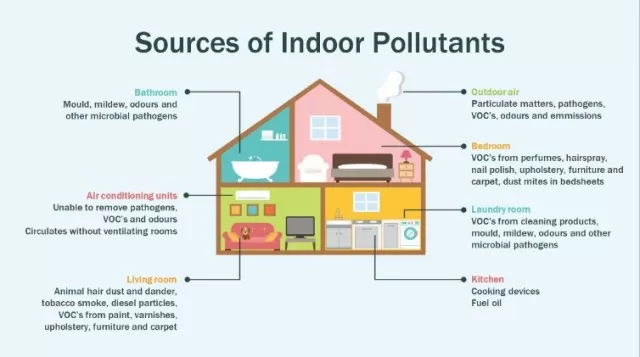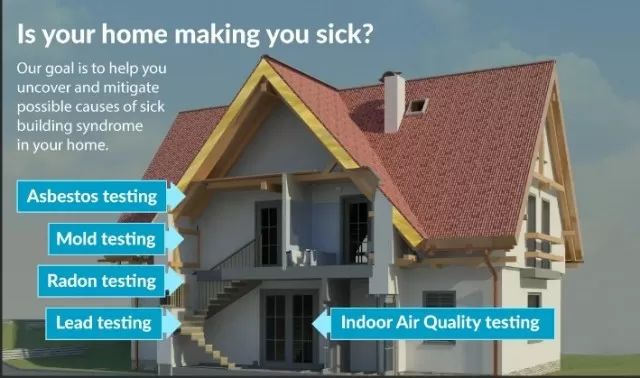Sick House Syndrome: How Your Home Can Make You Ill. According to the Environmental Protection Agency (EPA), a staggering majority of people spend over 90 percent of their time indoors. This sobering statistic begs the question: Could your very own living space be contributing to your declining health?
Amidst the comfort and familiarity of our homes, there may exist hidden dangers that have the potential to make us sick. Factors such as poor indoor Air Quality, the presence of allergens, exposure to harmful chemicals, and inadequate ventilation can all have a profound impact on our well-being.
By shedding light on these potential hazards and understanding their implications, we can take proactive steps to create healthier living environments. Whether it involves improving air circulation, addressing sources of indoor pollution, or implementing strategies to minimize exposure to allergens, safeguarding our health becomes a top priority.
Improving Your Well-being: Unveiling the Hidden Dangers of Indoor Air Quality

Unbeknownst to many, the quality of the air we breathe indoors plays a significant role in our overall health.
With a startling statistic revealing that 6 out of 10 homes and buildings suffer from Sick Building Syndrome (SBS), it becomes apparent that our very own sanctuaries could harbor potential threats to our well-being.
If you find yourself experiencing symptoms such as nasal congestion, dizziness, skin irritations, persistent headaches, or bouts of nausea—and if these discomforts magically vanish within a couple of hours after leaving a particular building—it is highly likely that Sick Building Syndrome is at play.
Moreover, SBS has also been linked to more severe health conditions like allergies, asthma, and chronic fatigue, making it imperative for us to take action.
To safeguard ourselves from the myriad of pollutants lurking in our living spaces, it is crucial to gain a comprehensive understanding of the factors within our homes that may be negatively impacting our health.
By identifying and addressing these risk factors, we can effectively eliminate potential dangers and prioritize our well-being. Embark on a journey to learn about the detrimental elements that might be compromising your health and empower yourself with the knowledge needed to create a healthier indoor environment.
Unveiling the Hidden Dangers: Unraveling the Truth about Poor Indoor Air Quality
It may come as a surprise, but the air we breathe outdoors generally surpasses the quality of indoor air.
Unfortunately, the limited ventilation within our living spaces creates a breeding ground for hazardous volatile organic compounds (VOCs) and other indoor pollutants. While modern homes with their efficient insulation excel at conserving energy, they also possess the unfortunate ability to trap these harmful toxins indoors.
To combat this issue, it is crucial to take proactive measures in maintaining a healthy indoor environment.
Embracing the opportunity presented by pleasant weather, open your windows to allow fresh air to circulate and effectively air out your home. Additionally, ensuring that all your vents remain open, unobstructed, and clear plays a vital role in maintaining the proper flow of air throughout your living spaces.
By shedding light on the truth behind poor indoor air quality, we can empower ourselves to make informed decisions and take necessary actions to mitigate the risks associated with indoor pollutants.
Together, let us strive for healthier living environments that prioritize the well-being of ourselves and our loved ones.
Revealing the Hidden Culprits: Unmasking Indoor Pollutants

You might be surprised to discover that the sources of indoor air pollution are often lurking right under your nose.
Substances such as formaldehyde and volatile organic compounds (VOCs) have a knack for hiding in plain sight, finding their way into various household items like carpeting, upholstery, manufactured wood products, and even common cleaning supplies. Unbeknownst to many, these seemingly harmless objects can release harmful pollutants into the air we breathe.
If you have plans for a renovation or are considering bringing new products into your home, it becomes crucial to exercise caution and be mindful of the potential toxins they may introduce.
Before making any purchases, take the time to diligently check product labels and ensure that you are not unknowingly inviting unnecessary pollutants into your living space.
By shedding light on these hidden culprits of indoor pollution, we can make informed choices to safeguard our indoor environments.
Together, let us take the necessary steps to minimize exposure to harmful substances and create a healthier, toxin-free haven for ourselves and our loved ones.
The Invasion from Outside: Guarding Against Outdoor Toxins Indoors
While the allure of fresh outdoor air entering our homes may seem appealing, it is important to acknowledge that not all outdoor air is beneficial for maintaining good indoor air quality.
In fact, certain contaminants, such as motor vehicle exhaust or diesel fumes, can find their way inside our living spaces through poorly located air intake vents, open windows, or other vulnerable openings, including the garage.
To fortify our homes against this invasion of outdoor toxins, it is crucial to take proactive measures.
Start by properly sealing off the garage from the rest of the house, minimizing the potential for pollutants to seep indoors. Additionally, installing a carbon monoxide detector in strategic locations within your home acts as an extra layer of protection, alerting you to any potential dangers.
By being vigilant and implementing these preventive measures, we can safeguard our indoor environments from the infiltration of harmful outdoor toxins.
Let us prioritize the well-being of our households by creating a sanctuary that promotes clean and healthy air for all to breathe.
Exploring the Science of Damp Zones: Unveiling the Effects of Bacteria, Mold, and Mildew

When it comes to sick building syndrome, bacteria, mold, and mildew play a significant role.
These troublesome elements tend to thrive in high-humidity environments such as basements and bathrooms, as well as areas where stagnant water has accumulated, such as drain pans, ducts, or leaky ceilings. Understanding how to prevent the growth of mold and mildew becomes crucial in safeguarding against respiratory issues and other ailments caused by these irritating agents.
By delving into the science behind damp zones, we can gain valuable insights into the mechanisms that contribute to the proliferation of bacteria, mold, and mildew.
Armed with this knowledge, we can proactively take measures to mitigate their presence and prevent their harmful effects.
Through implementing effective prevention strategies, we can create healthier living environments that minimize the risk of respiratory ailments and other health issues associated with these irritants.
Let us embark on a journey to explore the science of damp zones, empowering ourselves with the tools and knowledge needed to combat the challenges posed by bacteria, mold, and mildew.
.
.
*The information is for reference only.